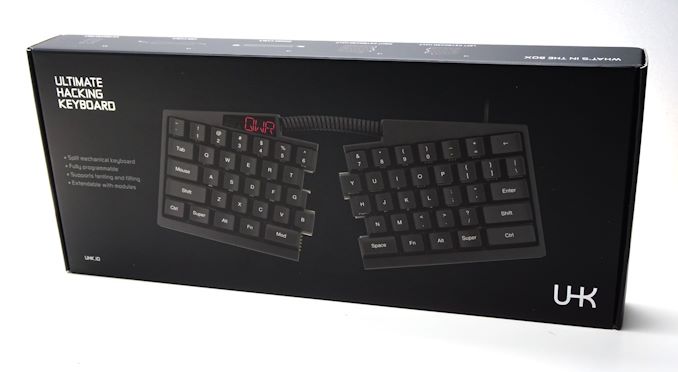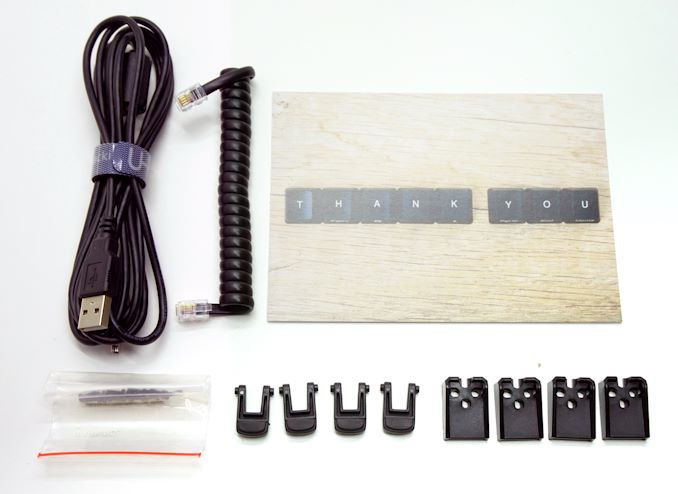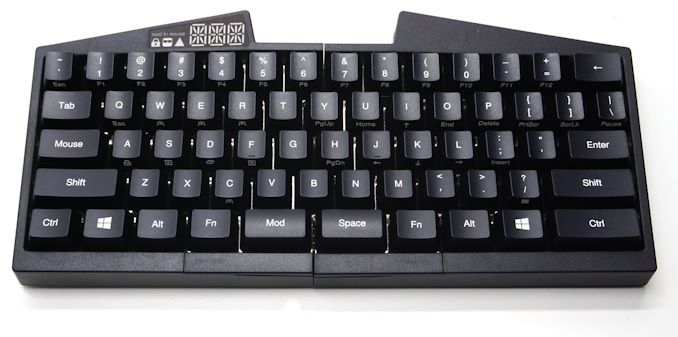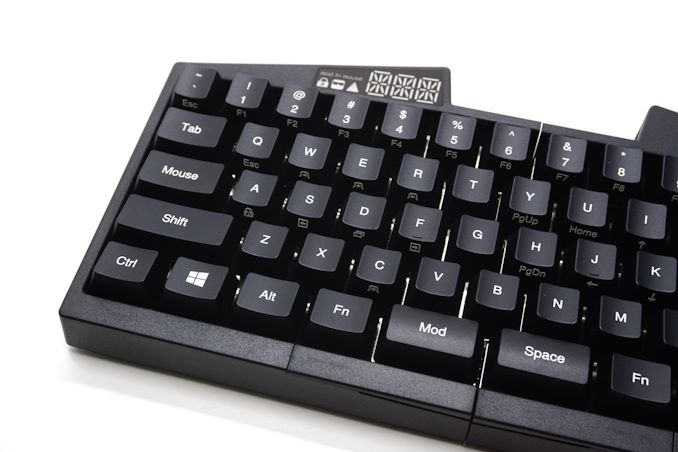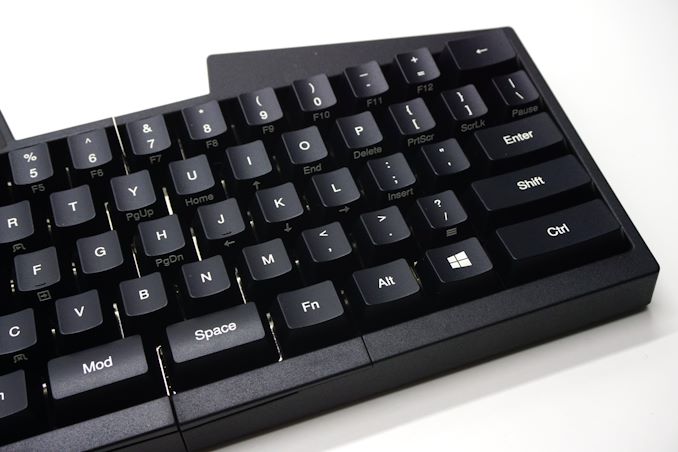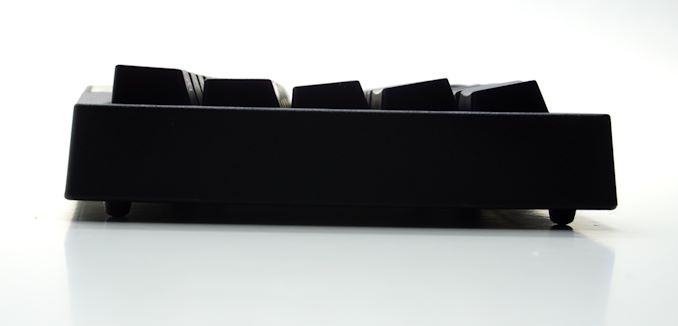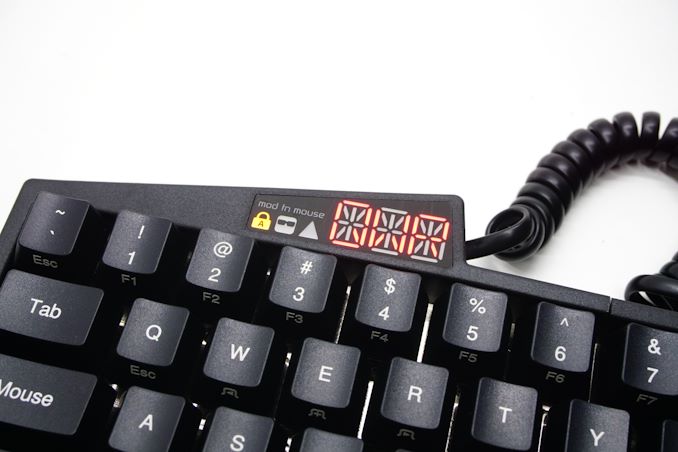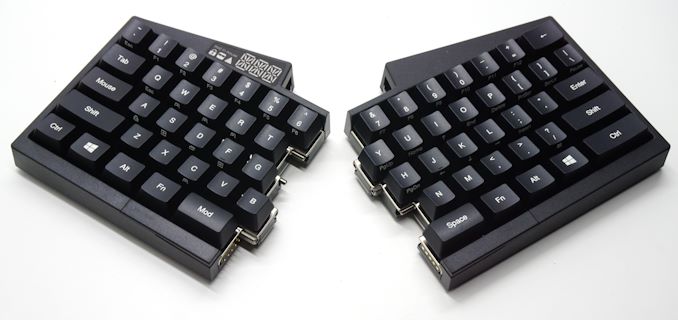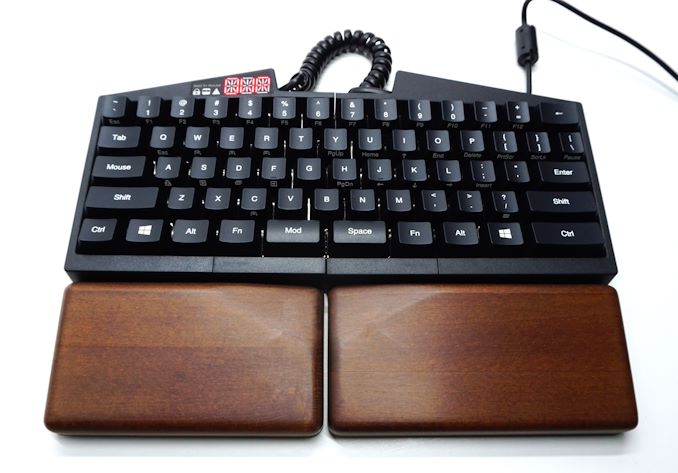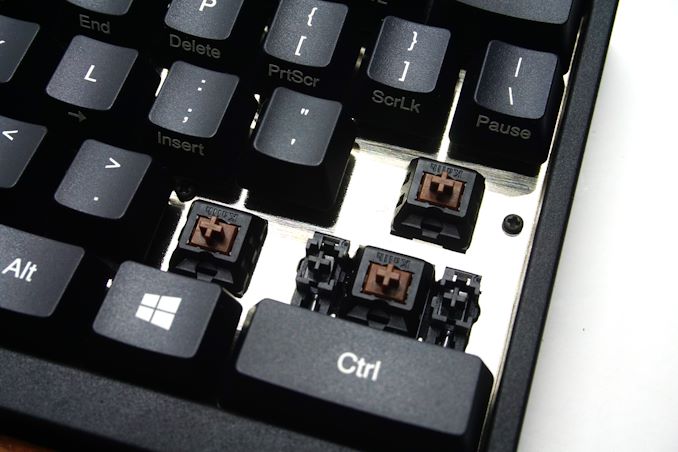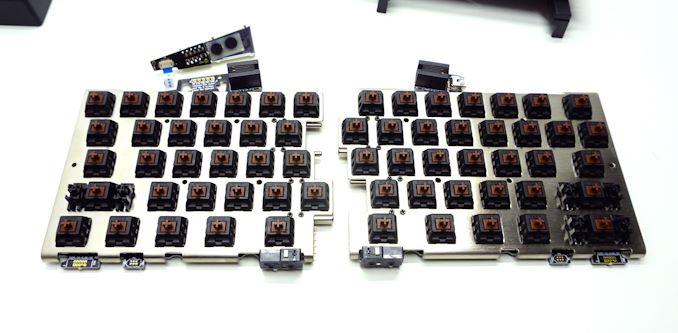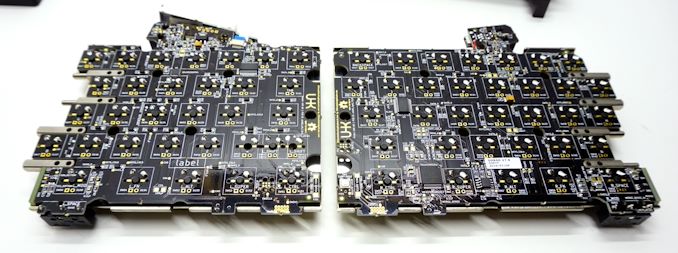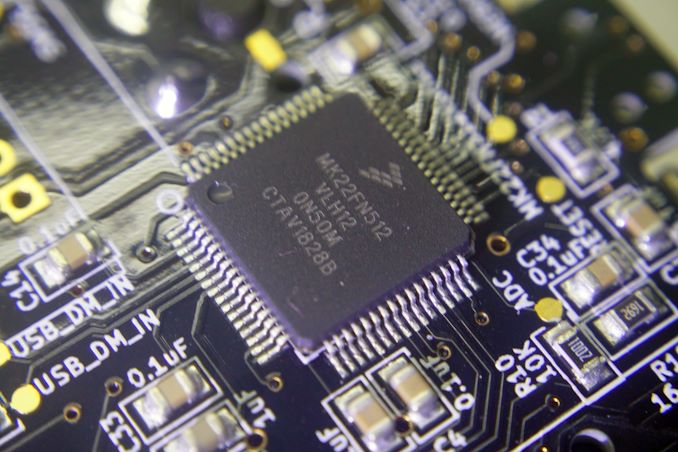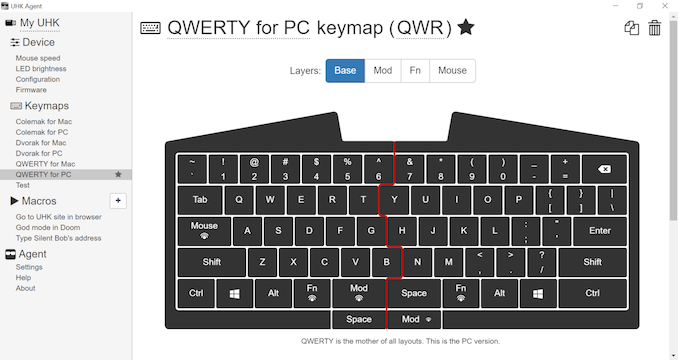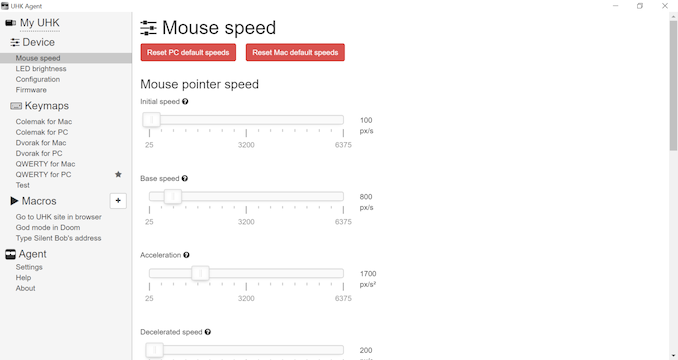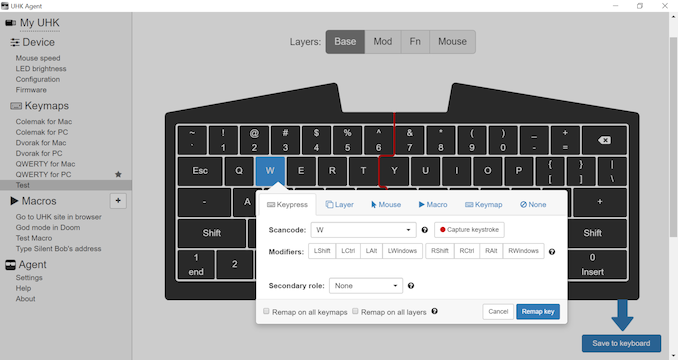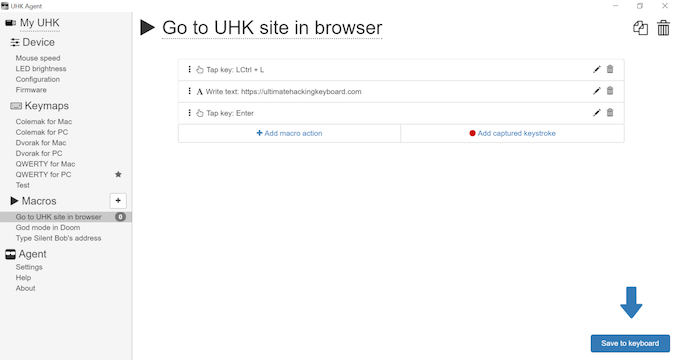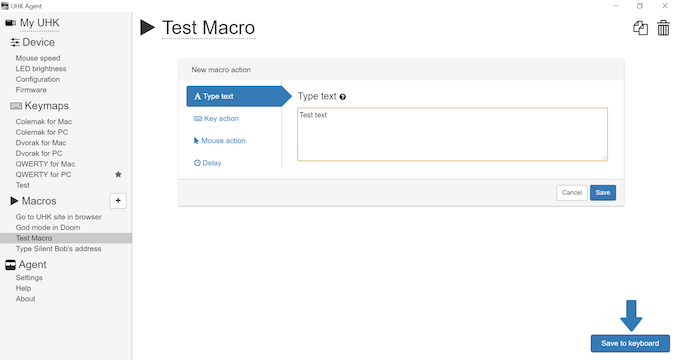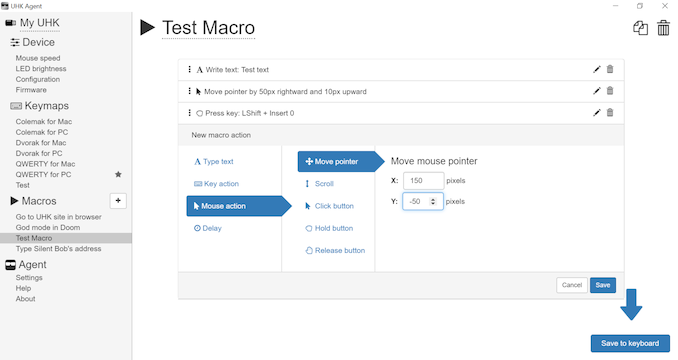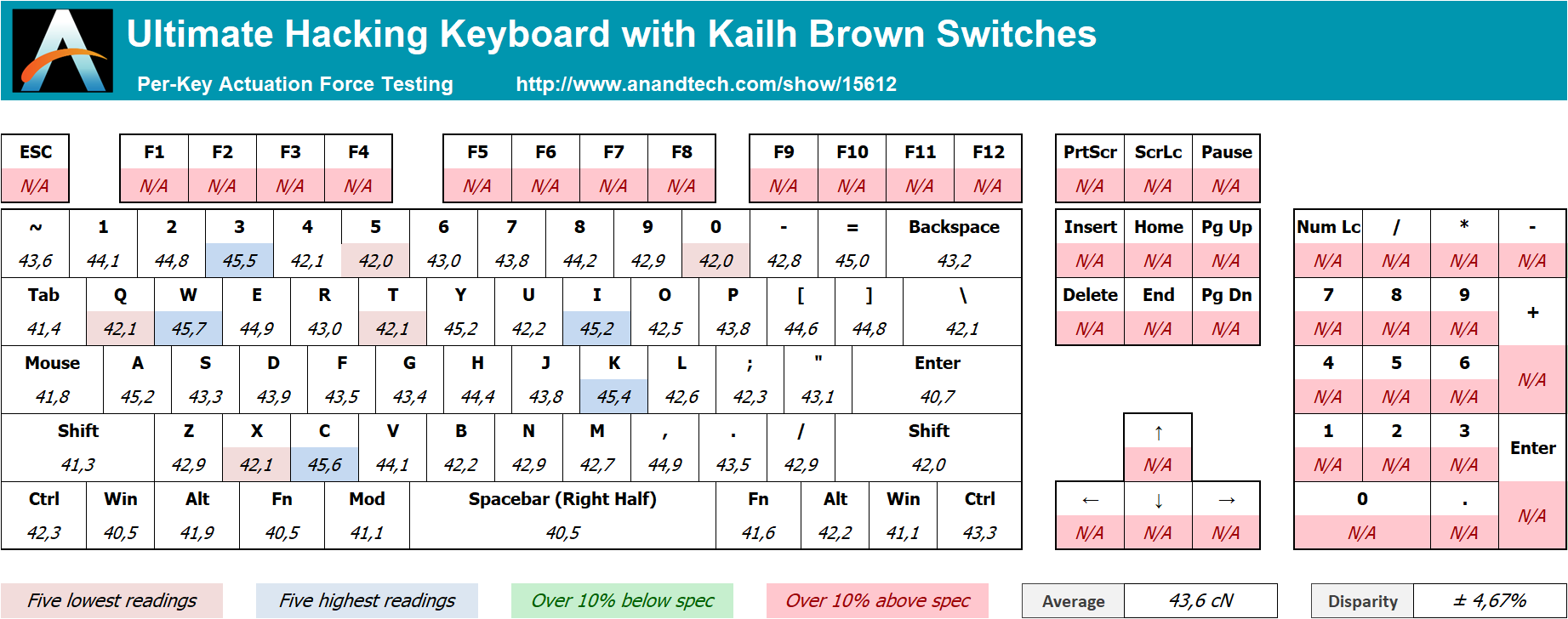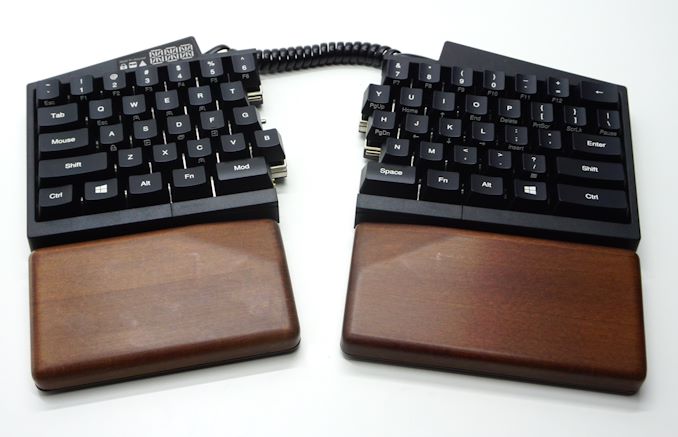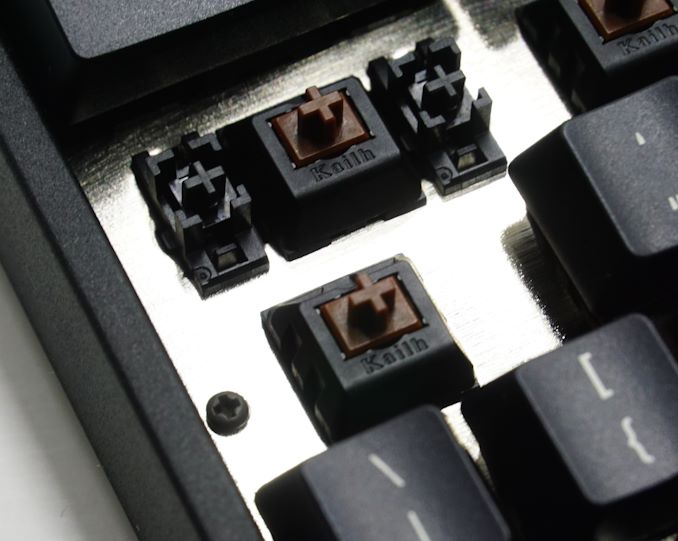
Original Link: https://www.anandtech.com/show/15612/the-ultimate-hacking-keyboard-review-truly-unique-for-pros
The Ultimate Hacking Keyboard Review: A Truly Unique, Truly Expensive Keyboard for Pros
by E. Fylladitakis on March 12, 2020 10:00 AM EST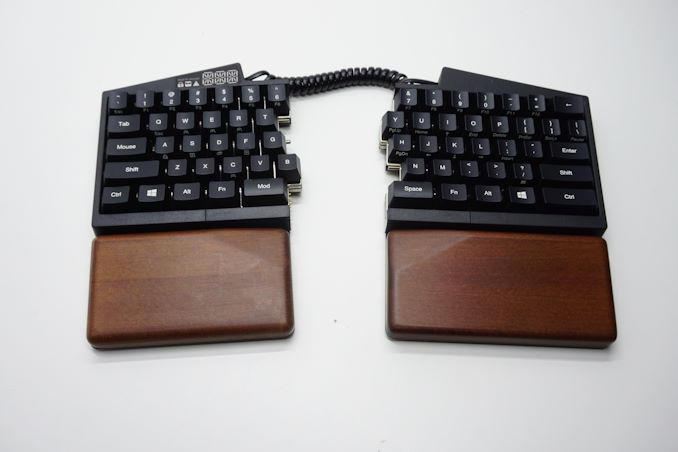
The explosive growth of the mechanical keyboard market over the past several years has led to an overly saturated market, with hundreds of products covering every desire and niche. Competition is certainly a good thing from a consumer’s point of view, but there is relatively little room to differentiate on features when it comes to keyboards, forcing most companies to focus their development and design efforts almost entirely on aesthetics.
Today we are taking a look at a product that (thankfully) breaks away from the norm: the Ultimate Hacking Keyboard. The company, Ultimate Gadget Laboratories, is currently exclusively focused on its development and marketing. It is a 60% mechanical keyboard designed with productivity in mind, implementing unique features and is made in Hungary – but also comes with an exorbitant price tag.
Diving right into matters, we received the Ultimate Hacking Keyboard inside an aesthetically simple cardboard box, with little artwork printed on it, yet very well-designed and practical. The keyboard and its bundle are neatly packed inside.
Inside the box, we found a basic user’s manual, one plastic keycap puller, a bag of rubber o-rings, and the keyboard’s USB cable. The o-rings are optional and can be purchased alongside the keyboard. They are meant to reduce the keystroke noise coming from the keycap bottoming down on the body of the switch but they will also reduce the effective key travel.
Dissecting the Ultimate Hacking Keyboard
The Ultimate Hacking Keyboard definitely is unlike any mechanical keyboard that we have reviewed to date. It is based on a 60% layout, making it the most compact mechanical keyboard that has ever come through our labs. The aesthetic design is simplistic and serious, as anyone would expect from a keyboard targeting very specific segments of IT professionals.
The 60% layout means that the keyboard is missing more than just its Numpad, as tenkeyless designs do. There are no arrow/control keys or a function key row at all. The standard function keys (F1-F12), control keys (Home, End, etc.), arrow keys, and more can be accessed by holding down the Fn key. It will be easy for an expert who has been using such a layout for a while to perform these functions but it will definitely be confusing for amateurs and users who switch between more than one keyboard every day.
The keycaps of the Ultimate Hacking Keyboard are simple ABS plastic, with the company offering more durable PBT keycaps as an extra. The main keys have their symbols printed right at the center of the keycap, while keys with extra characters have their primary and secondary characters printed towards the bottom and the top of the keycap respectively. Most keys also have a third character/function printed to their front side, which indicates the default function of the key while the Fn key is being held down.
The Ultimate Hacking Keyboard also has two more keys meant for keystroke combinations – the Mod and Mouse keys. The Mod key is to the left of the Space Bar and the Mouse key is where the Caps Lock key is by default. This means that every layout of the keyboard can simultaneously have four different layers – the default layer, the Fn layer, the Mod layer, and the Mouse layer. Using the software, users can also choose for the layers to be active only while the appropriate key is being held pressed, or for a key to permanently toggle the layout to that layer. A seasoned expert can program more functions into a single profile than a regular person can possibly remember.
The 60% layout of the Ultimate hacking keyboard does not follow any established ISO/ANSI standards. The bottom row will appear to be entirely chaotic for most users, with the Space Bar key being smaller than the Ctrl key. There are two buttons below the Space Bar and Mod keys, hidden within the design of the keyboard’s frame. A sizable three-character display can be found at the top left part of the keyboard, next to the subtle indicator LEDs.
Perhaps the basic feature of the Ultimate Hacking Keyboard is that it can be split in two. The stock cable provided allows for the two halves to be placed up to 30 cm apart, with the company providing instructions on how to make your own cable as well. The keyboard is designed so as to take expansion modules (trackball, touchpad, extra keys, etc.) but none of these modules were available to us at the time of this review.
The company provided us with a set of wrist rests for the Ultimate Hacking Keyboard, which are made of real wood. They are not very soft but certainly feel very classy. These also add the options of tenting and negatively tilting to the keyboard, which can only be positively tilted without the wrist rests attached.
Removing the keycaps of the Ultimate Hacking Keyboard reveals mechanical switches made by Kailh, a huge surprise for a keyboard of this price range. They do offer the keyboard with original Cherry MX switches but only the Green and White variants are available, at no extra cost. Choosing any of the “standard” switches, Red, Blue, Brown, or Black, Kailh switches are the only available option. It is possible that the manufacturer cannot source original Cherry MX switches for some reason and is forced to go with Kailh switches instead.
Removing the plastic frame of the keyboard reveals two PCBs with Kailh mechanical switches attached and shiny steel plates providing mechanical support. It is a shame that the keyboard has no backlighting, as we suspect that the polished metal would make it look great at low intensity levels. The assembly job is excellent but the metal is not too sturdy on its own, relying on the thick plastic frame for mechanical strength.
The heart of the Ultimate Hacking Keyboard is an NXP K22 series microcontroller (MK22FN512). It is a very powerful microcontroller with an ARM-based 120 MHz processor, 128KB of RAM, and 512KB Flash memory. Such a microcontroller is a little bit of an overkill for a keyboard without fancy backlighting to worry about and highly advanced Macro commands – then again, a little bit of processing power overkill never hurt anyone.
The UHK Agent Software
Most new keyboard releases suffer when it comes to software – it often is too simplistic, or buggy, or both. This is definitely not the case for the Ultimate Hacking Keyboard, as the company has clearly spent a lot of time and resources on the delivery of an excellent software suite.
At first sight, the UHK Agent software appears to be very simple. There is a single toolbar to the left that lists all device, layout, macro, and software settings. The device settings are the most simple of all, allowing the user to manipulate mouse settings (only mouse-related functions while using the UHK, it does not affect the actual mouse), and tweak the brightness of the LEDs. We should once again mention that the keyboard has no backlighting and tweaking the brightness of the LEDs only affects the three-character screen at the top left side of the board.
By default, the UHK has six different profiles programmed into it (QWERTY, COLEMAK, and DVORAK for Windows and Mac). Users can easily generate and save new profiles, the number of which is limited only by the (sizable) memory of the keyboard. Each profile has four layers and every key and button of the keyboard can be reprogrammed, allowing absolute programming flexibility. The software even allows for each key to have both a primary and a secondary role per layout, changing its function depending on whether it is being pressed alone or in combination with another key. Although this function probably is far too complex for regular users, experts could work wonders with it.
The Macro programmer of the UHK Agent software is relatively simple but quite powerful. Macros can be programmed to include anything from simple keystrokes to mouse movements, with the software allowing full manipulation of any delays as well. Note that mouse movements currently are limited to relative movements and not absolute coordinates. There is a workaround for that, i.e. experts can set the sensor to jump at an edge of a screen and work their way with relative movements from there, but including absolute movements directly into the software is always a good thing.
The only downside with the Agent software is that, for the time being, it does not seem possible for users to manipulate what is being displayed by the three-character LCD on the keyboard. As such, the LCD only indicates which layout is active (QWR for QWERTY, COL for COLEMAK, etc.).
Per-Key Quality Testing
In order to test the quality and consistency of a keyboard, we are using a texture analyser that is programmed to measure and display the actuation force of the standard keyboard keys. By measuring the actuation force of every key, the quality and consistency of the keyboard can be quantified. It can also reveal design issues, such as the larger keys being far softer to press than the main keys of the keyboard. The actuation force is measured in Centinewton (cN). Some companies use another figure, gram-force (gf). The conversion formula is 1 cN = 1.02 gf (i.e. they are about the same). A high-quality keyboard should be as consistent as possible, with an average actuation force as near to the manufacturer's specs as possible and a disparity of less than ±10%. Greater differences are likely to be perceptible by users. It is worth noting that there is typically variance among keyboards, although most keyboard companies will try and maintain consistency - as with other reviews, we're testing our sample only.
The machine we use for our testing is accurate enough to provide readings with a resolution of 0.1 cN. For wider keys (e.g. Enter, Space Bar, etc.), the measurement is taking place at the center of the key, right above the switch. Note that large keys generally have a lower actuation force even if the actuation point is at the dead center of the key. This is natural, as the size and weight of the keycap reduce the required actuation force. For this reason, we do display the force required to actuate every key but we only use the results of the typically sized keys for our consistency calculations. Still, very low figures on medium sized keys, such as the Shift and Enter keys reveal design issues and can easily be perceptible by the user.
Kailh’s switches are not quite the best in the market right now, but we usually get good quality figures when testing keyboards using them. Their switches may not be as good as original Cherry products, but they tend to perform well and are reliable. With an average force at the actuation point of 43.6 cN and a disparity of ±4.67% across the main keys, the Ultimate Hacking Keyboard is no exception to that rule. The force at the actuation point is slightly lower than the switch’s tipping point force, so our figures are spot-on for Brown-type switches. The Space Bar is virtually no different than the rest of the keys, as its mass is much smaller than that of a typical keyboard.
Hands-on Testing
I always try to use every keyboard that we review as my personal keyboard for at least a week. My typical weekly usage includes a lot of typing (about 50-100 pages), a few hours of gaming and some casual usage, such as internet browsing and messaging. I personally prefer Cherry MX Brown or similar (tactile) switches for such tasks, meaning that the Ultimate Hacking Keyboard should be, as far as the switches are concerned, ideal for my needs.
While the switches were great, it took me days to get partially acclimated to the 60% layout, even though I had used other split keyboards in the past. As end up using more than three different keyboards each day, it was difficult for me to generate muscle memory specific for the non-standard layout of the UHK. Those who are using just one keyboard daily will surely learn how to use the UHK efficiently much faster. Once I was used to the layout, I could work with the UHK about just as fast as I would with any good keyboard, yet not faster.
The 60% layout is meant to minimize finger movements and increase productivity, but having to resort to multi-key combinations actually slowed me down. I probably could not go any faster because I needed to switch to other keyboards during the day, or just because I have not been using the UHK long enough. An expert IT professional who will tailor the keyboard to his/her work environment and needs will probably become measurably more productive using it over a standard layout keyboard.
When it comes to gaming, the UHK may not be the most sensible choice, yet it works surprisingly well. Advanced gamers can reprogram the keyboard’s layouts and layers to generate game-specific commands and macros, while the split layout is especially useful to FPS gamers who can get rid of the right half completely and maximize their mouse space. It is not a keyboard developed specifically for gaming but it could work for professionals who enjoy combining business with pleasure.
Conclusion
Unlike the vast majority of mechanical keyboards nowadays, the Ultimate Hacking Keyboard truly is a unique product - a wholly unique design that is being marketed almost exclusively towards IT professionals. The developer of the keyboard designed it to be reliable and easily customizable, without the extraneous bells and whistles that would be unnecessary for a professional.
As a keyboard targeted towards professionals, the UHK is based on a 60% layout in order to maximize productivity and reduce fatigue. However, this is going to actually work only with professionals who use a single keyboard every day and will tailor the UHK to their specific work needs. For everyone else, having to result to multi-key combinations for virtually anything else but basic input will probably have a negative impact.
The customizability of the UHK is its greatest selling point. Its Agent software initially seems simple but can be used to create very complex layouts and layers, making it a true weapon at the hands of an experienced professional. Users can also expand/customize their keyboards with additional modules that are available from the manufacturer for about $60 each, allowing the tailoring of the UHK to their specific needs.
The only real issue with the UHK is its unreasonably high price tag. It is currently retailing at $275 plus shipping, and this is without any of its accessories. The palm rest alone costs an additional $75, which is more than a whole mechanical keyboards using Kailh switches retails for nowadays. And the complete price tag for the UHK system can go higher still, as the future expansion modules will another $60.
Meanwhile, although the pricey keyboard is appropriately extravagant in some ways, it's also not very impressive in others; at it's core you're still looking at a keyboard built using Kailh switches, and lacks even basic backlighting. While we cannot deny the excellent quality and customizability of the UHK, it lacks enough features to fully justify such a price tag.
To summarize, we believe that the market potential of the UHK is significantly limited. It is, at the same time, both the smallest mechanical keyboard and the most expensive mechanical keyboard that we have ever reviewed. But its feature set, while impressive at times, just can't justify such a humongous price tag. The UHK is a product designed strictly for a small percentage of IT professionals and experts – it may be a real toolbox at the hands of an IT expert, but also is an unreasonably expensive choice for practically everyone else.

